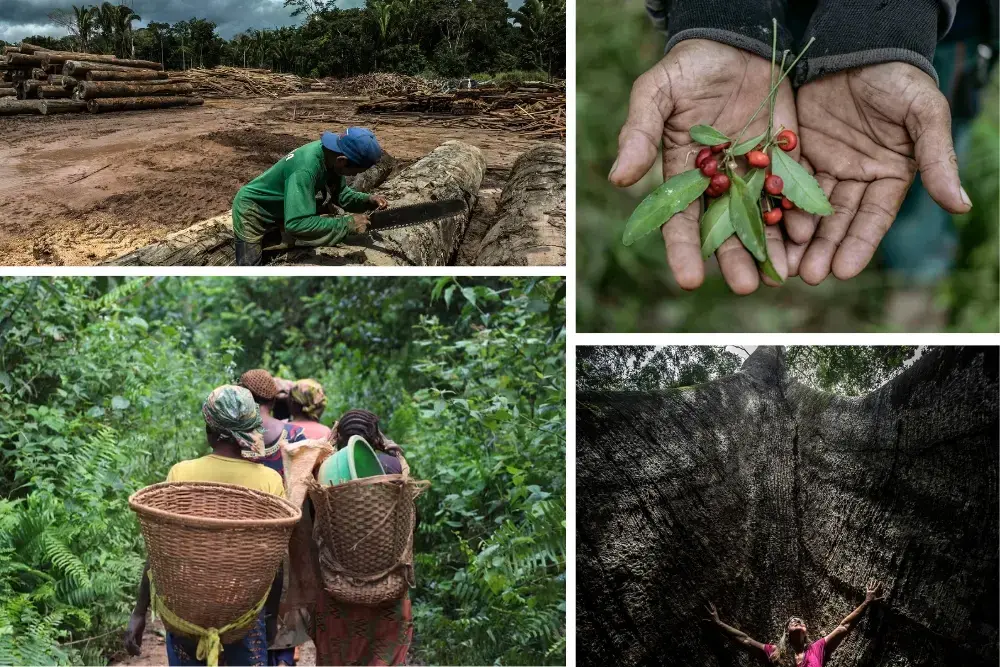
Introducing a New Phase of Rainforest Reporting Grants
The titles say it all: “Trouble in the Amazon,” Rainforest Defenders, Gold Mining at Kellé in West Cuvette, When the Forests Fall Silent. These are stories about the devastations, injustices, and fights taking place in the world’s most important rainforest regions: the Amazon, the Congo Basin, and Southeast Asia. Despite the threats they face, these rainforests are expected to safeguard ecosystems, sustain livelihoods, and address the climate crisis.
Since 2018, the Pulitzer Center, through the Rainforest Journalism Fund, has supported journalists in reporting on issues facing forests in these regions and amplifying the voices of people who are affected the most. They shed light on systemic issues, such as corrupt forest governance, industry-driven deforestation and conflicts, violations of Indigenous and human rights, and more.
In Mercury Alert, investigative reporters looked into the mercury trade in six South American countries that is fueling illegal mining and causing massive deforestation. Another investigation traced the soybean supply chain from farms in the Brazilian Amazon to the European feed and meat industry. In Cameroon, a large-scale agro-industry led to land grabbing and detrimental deforestation.
Some stories capture the spirit of determination and hope. We are awed by the bravery and grit of the Indigenous women-led fire brigade combating wildfire in the Amazon. Or the journey of a linguist and the last speaker of the Iskonawa language in Peru to save the endangered language. Finally, a story about the resilience of Boti tribe members in Indonesia, who managed to preserve their forest and be food self-sufficient by adhering to customary practices.
In 2023, we concluded this phase of the rainforest grant with these impressive numbers: 50 countries, 330 projects, 600 journalists, and 1,700 stories.
Yet, there are still stories to be shared, rights to protect, negligences to be accounted for. And most importantly, a chance for the rainforest to play its role.
To continue supporting these crucial stories, we are opening new Rainforest Reporting Grants. We are enthused by projects that will further delve into undercover exploitations, protection of land rights, cross-border operations, and innovations that lead to climate resilience. As our new mission states: We seek stories that can “inspire action.”
Our commitment to rainforest reporting remains unwavering. We invite journalists to learn more about this grant opportunity and join our reporting community.
To learn more about the work of the Rainforest Journalism Fund and the transition to the Rainforest Reporting Grants, you can read our reflection here.
Best,

Impact
On February 17 and 18, 2024, nearly 700 participants gathered virtually for The 1619 Project Education Conference. Four panels led by 18 members of The 1619 Project Education Network focused on methods for integrating project resources and themes into course-aligned curricular projects that led to local historical research, original poetry and essays, community partnerships, and more. This year’s conference also featured the launch of applications for The 1619 Education Programs Impact Grant initiative, inviting education professionals to use resources from The 1619 Project to:
- Improve the awareness and critical thinking of students and educators about the legacies of slavery in the contemporary United States, and the contributions of Black Americans to every aspect of U.S. society
- Equip students and educators to take action and make change that advances racial justice.
1619 Project creator Nikole Hannah-Jones described the ongoing mission of The 1619 Project in the opening remarks. “Our students benefit so much from the way you all have taken this project and turned it into curriculum across fields … It helps our world make sense to them,” she said. “The work that you do matters. It has always mattered, but it’s even more critical today.”
To learn more about The 1619 Project Education Conference, visit our update here.
Photo of the Week

"This project means an opportunity to celebrate those people who do not define their worth by the money they make but by the lives they positively impact. I have turned my camera toward those who labor tirelessly to see justice realized for all."
—Tara Pixley
This message first appeared in the March 1, 2024, edition of the Pulitzer Center's weekly newsletter. Subscribe today.
Click here to read the full newsletter.

Project
Season II: Rainforest Defenders
A new "Rainforest Defenders" season will bring stories of young leaders fighting back.

Gold mining in Kellé in West Cuvette causes an ecological disaster in the locality: populations and...

Project
When the Forests Fall Silent
South-east Asia’s forests are becoming eerily silent as animals fall prey to snares and traps; a...

Project
Mercury Alert
Mercury, the toxic quicksilver that pumps through the veins of gold miners is a necessary evil to...

Project
Hungry for Meat?
The appetite of one of Germany's richest industries is threatening the planet's most valuable...

A documentary reveals illicit practices used by a Chinese agro industry farm to kill Cameroon's...

Project
Women Against the Fire
The Apinajé people created the first female Indigenous brigade in the Amazon.

This project will take a critical look at a controversial forest carbon project in the Madre de Dios...

The diversity of food sources and culture which is the foundation of a sustainable local food system...


























